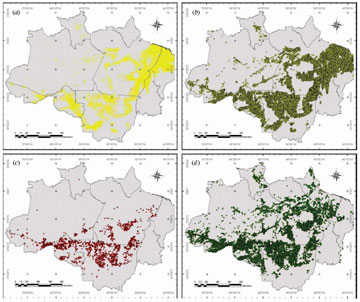Amazon fires intensify despite drop in deforestation rate
Amazon fires intensify despite drop in deforestation rate
Rhett A. Butler, mongabay.com
February 19, 2008
Fire policy is key to reducing the impact of drought on the Amazon
Gaining control over the setting of fires for land-clearing in the Amazon is key to reducing deforestation and the impact of severe drought on the region’s forests, write researchers in a paper published in Philosophical Transactions of the Royal Society B.
Analyzing rainfall, fire and deforestation for the Brazilian Amazon from 1998 through 2006, Oxford University’s Luiz Eduardo O. C. Aragão and colleagues from the Brazilian Institute for Space Research (INPE), NASA’s Jet Propulsion Laboratory and Free University of Brussels found that despite a 31 percent reduction in the deforestation rate over the prior year (2004), during the drought of 2005 the Amazon saw a 43 percent increase in the number of fires relative to the expected value for a similar deforested area. The results suggest that “extreme droughts can increase significantly the number of fires in the region even with decreased deforestation rates.”
 Maps of the Brazilian Amazonia showing (a) the total cumulative deforested area based on the INPE-DETER dataset until 2004 ( yellow) and in 2005 (red), and the annual cumulative number of hot pixel detections in 2005 from NOAA-12 dataset over (b) areas deforested until 2004, (c) areas deforested in 2005 and (d ) forested areas in 2005. Image copyright Luiz Eduardo O.C. Aragão at al (2008), Phil. Trans. R. Soc. B. |
The authors expect this relationship to continue as deforestation and human-induced climate change act in concert to increase the frequency and intensity of drought in parts of the Amazon.
“We may expect that the ongoing deforestation, currently based on slash and burn procedures, and the use of fires for land management in Amazonia will intensify the impact of droughts associated with natural climate variability or human induced climate change, and therefore a large area of forest edges will be under increased risk of fire,” write the authors.
While their outlook is dire, Aragão and colleagues say the most effective policy action will be reducing the use of fire in converting forest for agriculture and pasture.
“The impacts of fires on the Amazonian region could be reduced with the support of governments, since fires here are mainly induced by human activities and could be avoided and/or diminished by: the introduction of fire-free land management techniques; reinforcement of monitoring, controlling and application of the current Brazilian legislation to illegal fires; creation of protected areas; and environmental education programs,” the authors write, pointing to the creation the Extractive Reserves statutes, the Pilot Program to Conserve the Brazilian Rain Forest (PPG7), and Ecological-Economic Zoning (ZEE) as hopeful signs.
The authors further note that despite the negative ecological impacts of large-scale mechanized agriculture, such farms and plantations are “not normally accompanied by subsequent fires… which can potentially reduce the risk of forest fires in Amazonia… once the Ecological-Economic Zoning of the Amazonian region has been well stabilized.”
In other words, once deforestation has been brought under control, protected areas established, and agricultural areas zoned, well-managed agroindustry could reduce the indigence of fire in Amazonia.
Luiz Eduardo O.C. Aragão at al (2008). Interactions between rainfall, deforestation and fires during recent years in the Brazilian Amazonia [FREE OPEN ACCESS]. Phil. Trans. R. Soc. B, DOI: 10.1098/rstb.2007.0026







